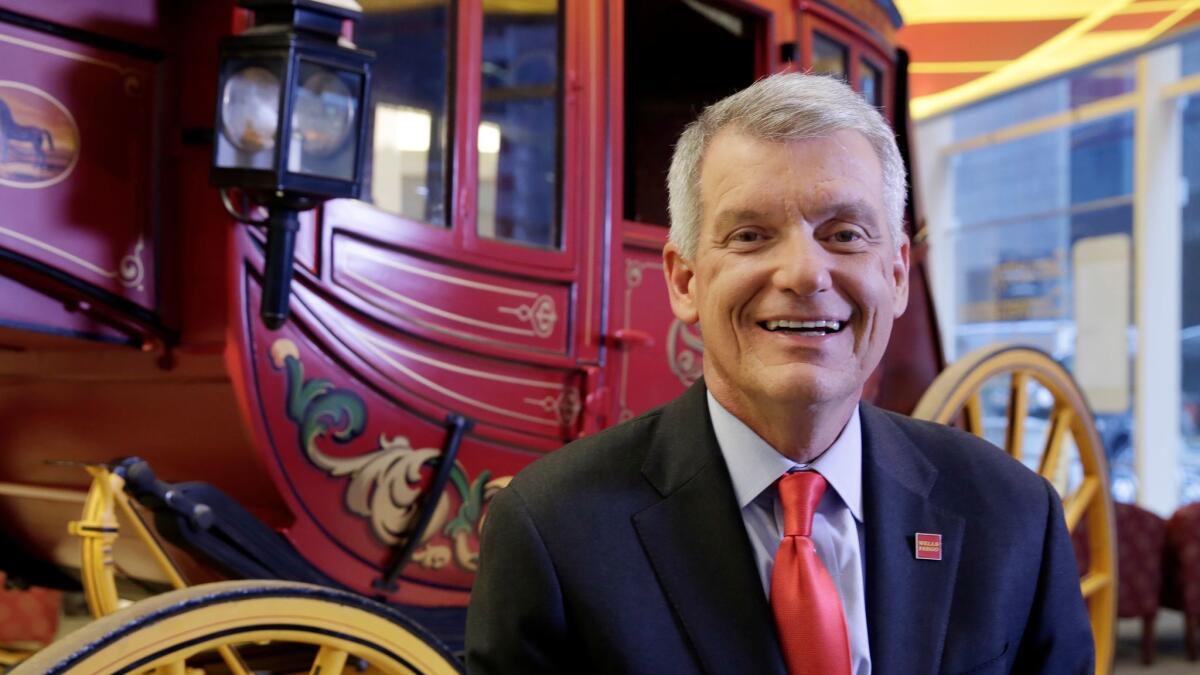Column:: Customers still seem wary of doing business with Wells Fargo — with good reason

Wells Fargo & Co. continues to provide a counter-example to the adage that there’s no such thing as bad publicity. Six months after the scandal broke of widespread fraud in its customer sales practices, the bank is still struggling to line up new customers.
Potential customers may feel they have good reasons to steer clear of Wells Fargo: Its commitment to do everything it can to rectify the fraud — “to make things right and restore trust,” as its publicity material says — is still highly questionable. The company has acknowledged that its retail sales force opened as many as 2 million checking, savings and credit card accounts without customer authorization over the last several years, and it agreed to pay $185 million to regulators to settle investigations into the scandal.
The bank says it has refunded millions of dollars to potentially defrauded customers and reached out to 43 million more. But Wells Fargo still is trying to force aggrieved customers into binding arbitration, rather than in court, where they might have a better shot at gaining redress. As long as Wells Fargo insists on playing on a field tilted in its own favor, all its claims about doing the right thing by its customers ring hollow.
Wells Fargo admitted in sworn testimony that it broke the law, and that it stole customers’ money.
— Mitchell vs. Wells Fargo
Before we get into that, let’s look at the raw numbers. Since October, as part of a campaign aimed at “greater transparency,” the bank has issued monthly customer statistics, including account openings and closings. So far, they’ve been ugly. (See accompanying chart.)
New checking account openings are running an average of 40% behind the same months a year earlier, and new credit card accounts are down by almost 50%. It isn’t entirely clear whether the comparisons are so bad because the year-ago period includes bogus accounts.
In any event, Wells executives point out that new checking accounts have been running ahead of customer-initiated account closings each month, which they take as a good sign. But it’s not that good: Net new account openings have run about 100,000 per month since the scandal broke. In the year-ago period, net new accounts were running 300,000 to 400,000 per month. And customer loyalty scores, the bank concedes, are still significantly below pre-scandal levels. Those factors suggest that the bank is still facing strong headwinds in attracting customers.
Why might that be? First, much of Wells Fargo’s commitment to “making things right” is indistinguishable from advertising persiflage. Its chief executive, Tim Sloan, who took over from disgraced Chairman and CEO John Stumpf in October, uttered some of this boilerplate at an employee town hall on Tuesday, where he unveiled a new corporate brand ad campaign erected around the slogan “Building Better Every Day.”
“It’s not just a tagline,” Sloan said of this vacuous marketing phrase. “It’s our commitment.” He talked about fostering an “ethical, inclusive and customer-focused culture.” Among the company’s six new goals, he said, were that “we want to know and understand our customers and their financial goals.”
Yet when it came to concrete commitments, there was not much new. The $3.2 million in refunds the company has made? That’s gone to 130,000 customers, so it comes to $24.61 each. Is that enough to compensate customers whose credit scores may have been torpedoed by accounts they didn’t know they had, or checks they bounced because a Wells employee had drained their real account to bankroll a fake one? No, but their anguish is covered by Sloan’s assurance that “we’re researching how our customers’ credit scores may have been impacted as the result of potentially unauthorized credit cards.”
If one pays attention to actions and not words, however, Wells Fargo is still failing to make things right for its customers. The best illustration of that is its treatment of the customers who have filed suit in federal court over the bogus accounts. Citing customer account agreements the customers allegedly signed, the bank wants these cases thrown out of court and moved to arbitration.
Wells Fargo contends that once a customer signs an agreement with an arbitration clause, all disputes that customer has with the bank are subject to arbitration — including, as in these cases, allegations of fraudulent activity. In a motion in Utah federal court, the bank points to a clause in the agreement that subjects to arbitration “claims based on broken promises or contracts, torts (injuries caused by negligent or intentional conduct), or other wrongful actions.”
The bank also maintains that the very issue of whether these cases are subject to arbitration is itself subject to arbitration.
The customers, however, argue that once the bank allowed criminal activity to take place, it breached the customer agreements, so they no longer apply. And the bank has acknowledged that its employees were setting up bogus accounts for years, that it knew enough about the activity to have fired more than 5,000 wrongdoers, but that it failed to disclose the activity to the customers or the public — at least not until the scam was uncovered by the Los Angeles Times in 2013.
“Wells Fargo admitted in sworn testimony that it broke the law, and that it stole customers’ money,” the customers say in their lawsuit. Since the illegal conduct took place outside the accounts the customers had opened, that should place it outside the arbitration agreement, says the lawyer handling the Utah case, Steven A. Christensen.
Wells Fargo has been urged by senators and members of Congress to drop the arbitration clause, which has been upheld by one federal judge in a case related to the scandal, Vince Chhabria of San Francisco. And Christensen says Wells Fargo shows no signs of relenting in his case, which he says involves 100 customers. The bank is “holding fast and firm,” he told me. A bank spokesman confirmed that.
As we observed when the Wells scandal first broke, arbitration clauses in customer agreements are a scourge that work largely against the customers. Typically, they’re buried in the lengthy documents you sign when you enroll with a cable company, go to a doctor or hospital, or take a new job, and almost always they favor the bigger party — Wells Fargo, for example, will be party to perhaps hundreds or thousands of arbitration hearings per year, while the average customer may face one in a lifetime. The arbitrators know who butters their muffins, and they’ll tend to avoid getting a reputation as pro-customer, lest their business dry up.
Even worse, arbitration cases are generally held behind closed doors and their evidence kept out of public view. The Wells Fargo scandal might have been uncovered much sooner had customer complaints reached open court.
If Wells Fargo truly wants to show its commitment to putting this scandal behind it and making things right, it will forgo the arbitration clause. Until it does so, its pledges to act transparently and to be “Building Better Every Day” are just so much hot air, and its potential customers will know it.
Keep up to date with Michael Hiltzik. Follow @hiltzikm on Twitter, see his Facebook page, or email [email protected].
Return to Michael Hiltzik’s blog.
More to Read
Inside the business of entertainment
The Wide Shot brings you news, analysis and insights on everything from streaming wars to production — and what it all means for the future.
You may occasionally receive promotional content from the Los Angeles Times.











